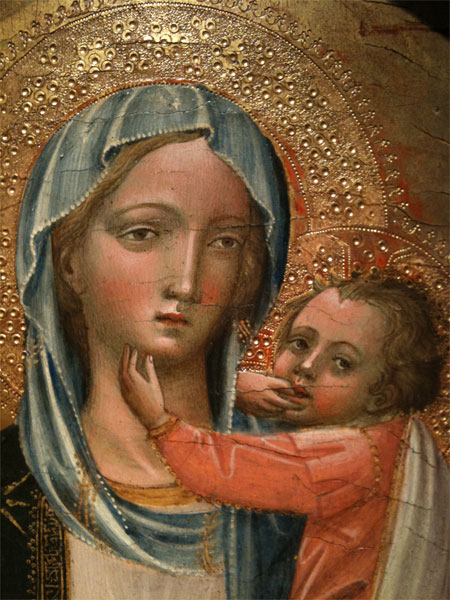
(Giovanni di Marco, called Giovanni dal Ponte, Madonna and Child enthroned between Saints Lawrence and Anastasia (detail), private collection; on show at Moretti’s “Dalla tradizione gotica al primo Rinascimento”.)

(Giovanni di Marco, called Giovanni dal Ponte, Madonna and Child enthroned between Saints Lawrence and Anastasia (detail), private collection; on show at Moretti’s “Dalla tradizione gotica al primo Rinascimento”.)
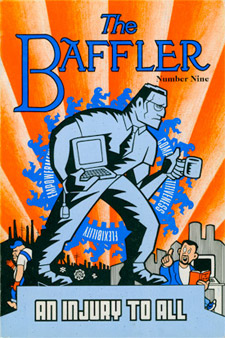 The Baffler #9: An Injury to All
The Baffler #9: An Injury to All
ed. Thomas Frank
Still working my way through old Bafflers: this one’s from 1997. I might be reaching my saturation point: this one took me a while to get through, in no small part because of what the editorial note describes as this issue’s “particularly unhappy tone”. This issue is unusually focused; most articles are on the sorry state of the labor movement in this country in the mid-1990s. Chris Lehmann looks at labor in the academy; Peter Rachleff looks at strikes against Hormel in Minnesota; David Moberg looks at attempts at organizing hotel workers in Los Angeles; Bob Fitch inspects the current state of the AFL/CIO. There’s some history as well: Frances Reed looks back at textile worker strikes in Lawrence, Massachusetts; Hunter Kennedy looks at the forgotten history of cotton strikes in Mississippi; an illustrated piece by Jessica Abel looks at the legacy of labor unrest in Decatur, Illinois, and Jim McNeill talks about his time as a labor editor in Racine, Wisconsin. It’s hard to read now: if anything, things are worse, and one senses that a lot of concerned people have simply thrown up their hands.
But: it’s good for you. And: there’s a lot here that’s useful. Tom Frank’s lead-off essay, a survey of labor writing through the ages is still relevant:
As a rule, advertising, the highest form of information-age cultural production, intentionally avoids discussing where products come from. In a time in which, we are told, style and image transcend all – both for corporate marketers and ourselves as consumers – essays like Edmund Wilson’s long description of the brutal facts of automobile production in “Detroit Motors” come across as nothing short of revelation. For a writer in the 1990s to produce such a piece – insisting on the inherently local, inherently material facts of work in an age when the only journalistic game in town is to wax blissful about the cyber-universe is eclipsing the analog world – would be almost willfully contrary. (p. 11.)
Change the date and it still works. Tom Vanderbilt’s “The Gaudy and the Damned” seems to have discovered a source for Mad Men, reading Chicken Soup for the Soul at Work (still in print, in turns out):
One story, titled “Santa comes to Joan,” caught my eye: “Every office has a Joan, or should have. She’s the one everyone looks to when the workload gets too heavy. She’s the one with the good story and the ready laugh. For our Christmas party, she’s the one who transforms our sterile corporate conference room, Christmas after Christmas, with tiny white lights, real teacups, teapots and plates she had brought from home.” (p. 15.)
And reading Josh Mason’s “Three Scenes from the Bull Market” now, one is surprised to discover that Jim Cramer of Mad Money and the real estate bubble got his start at the New Republic, where he suggested that laid-off workers could be quieted with stock options. Still hilarious, and available online at the SEC, is Wired‘s first, failed IPO, excerpted by Doug Henwood; they had operated at increasing loses for their first four years, but they were hopeful about making a lot of money off of suck.com in the future. Another prospectus, from Vans, touts how they’ll be more profitable as they’ve moved all their shoe manufacturing to South Korea.
As its title suggests, Jim Frederick’s “Intern Camp: The Intern Economy and the Culture Trust” looks at the culture of interning, then in a relative infancy. Obviously interning for for-profit corporations is a terrible thing, and there have been any number of pieces written about that. But Frederick’s piece is notable in that it examines the legal basis for internships:
There is, however, another exemption in the FLSA [the Fair Labor Standards Act, passed in 1988 (!)]. Vaguely worded, it concerns “trainees,” or the oddly redundant “student learners.” It allows for-profit institutions to pay short-term employees less than the minimum wage if they are there in an educational capacity. The Department of Labor requires that six criteria be met before it considers someone not an “employee” but a “trainee” exempt from the FLSA: The training is similar to that one would get in school; the training is for the benefit of the trainees, not the employer; the trainees do not displace regular workers; the employer derives no immediate advantage from the activities of the trainees, and may even incur some loss; the trainees understand that they are not entitled to a job at the conclusion of the training; and the trainees understand that they are not entitled to wages for the time spent in training. (p. 53.)
Frederick points out that some industries (banks, law firms, tech companies, engineering companies, and federal agencies) generally follow this; it’s abused by the glamor industries, fashion, architecture, and publishing, which use internships as a source of free labor. There’s a distinct class-based element to intern labor: it’s only relatively affluent young people who can move to New York and work for free in the hopes of getting a job down the road. (David Foster Wallace, more attuned to class differences than one might expect, would get this exactly right in “The Suffering Channel” where he describes a hierarchy of extremely well-dressed interns and the discomfort of his protagonist, working class reporter’s discomfort, with them.) One wonders how much the publishing industry has been hollowed out by two decades of reliance on interns: somebody should be looking at this.
At the end of the book, Robert Nedelkoff’s “Remainder Table” takes a look at the two books of the novelist Alan Kapelner, still neglected. I don’t know Kapelner’s work; LibraryThing reports that All the Naked Heroes was in the libraries of Carl Sandburg and Marilyn Monroe and Lonely Boy Blues was owned by Hemingway. I’d love a compilation of Nedelkoff’s “Remainder Table” columns; the books in them that I’ve tracked down have been worth the time.
And finally, Damon Krukowski had taken on the job of poetry editor with this issue: the selection here focused on poems about labor. Two poems, by Lizinka Campbell Turner (“Distinguo,” poorly scanned but in its original context here) and Edwin Rolfe (“Asbestos”), were rescued from The Liberator (1918) and The Daily Worker (1928); there’s also Kenneth Fearing’s “X Minus X” from 1934 plus Muriel Rukeyser’s “Metaphor to Action” from 1935. It’s an interesting selection, not least because it works well with the rest of the issue: one forgets that there was a sustained tradition of poems about labor, and that labor magazines published poetry. Somebody must have made a good anthology of this by now; I’m impressed that all four can now be found online.
Books
Films
Exhibits
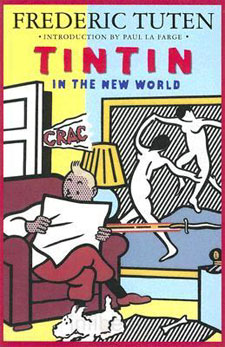 Frederic Tuten
Frederic Tuten
Tintin in the New World: A Romance
(Inprint Editions, 2005; original, 1993)
This is not a book that is well-served by the Internet. The Amazon reviews are almost unanimously damning; a LibraryThing one suggests that this is “Maybe the worst book ever written.” This is not the worst book ever written. It is a well-connected book: on the back cover, there are blurbs from Jonathan Coe, Susan Sontag, Larry McMurtry, and Leslie Marmon Silko. The copyright page explains that the Roy Lichtenstein cover was “created expressly for this novel”; another Lichtenstein drawing of the same subject serves as a frontispiece. The book is dedicated to “my friend George Remi (Hergé) and Roy Lichtenstein”. The novelist’s friendship with Hergé (real or metaphorical, I don’t know) is almost certainly what causes the online reviewer’s bad reactions: this is a book that takes Hergé’s characters and puts them into another context, along with a lot of characters from Thomas Mann’s The Magic Mountain. This is a fine conceit for a novel in the pop art tradition; however, it’s a formula that’s going to leave Internet browsers who assume this is a Tintin spinoff deeply unhappy. I picked my copy up at 192 Books: its presence there made it clear that it’s a certain type of book – more so because this copy was signed, implying that Frederic Tuten is the sort of author who reads at 192 Books. I picked it up because I knew that Tuten was associated with Donald Barthelme andFiction back at that journal’s beginnings, rather than because Tintin was in it (though Tintin, of course, doesn’t hurt); he’d been on my list of people to get around to reading for a while. But that sort of paratextual context tends to get lost on the Internet. This is, among other things, a book about Tintin, and that seems to be how the Internet insists on reading it.
But this book. Tintin, at Marlinspike with Captain Haddock and Snowy, is at loose ends; he wants something to involve him. A letter from Brussels, one presumes from Hergé, summons Tintin to Peru where an adventure should happen. No adventure happens. Instead, Tintin promptly meets the secondary characters from The Magic Mountain: Peeperkorn, Settembrini, Naphta (whose name has become “Naptha,” perhaps so that it’s not pronounced “NAFTA,” or perhaps to suggest naupathia), and Clavdia Chauchat. Tintin becomes Hans Castorp; Captain Haddock mostly fades away, a drunk resigned to his fate. Snowy is philosophical and doesn’t assume that anyone will understand him since he lost the power of language early in the Tintin series. Tintin finds love with Clavdia; eventually, he does in Peeperkorn. The complementary Settembrini & Naptha end up as lovers. Tintin finally leaves the mountain to become a savior to the natives.
Mixing and matching characters from earlier books has become commonplace in the past decade, whether in fan fiction on the Internet or in the bookstores with Sense and Sensibility and Sea Monsters. It’s hard to remember how radical this would have seemed even in 1993; this book follows hard in the tradition of Barthelme, both in his love of the readymade and in his strategy of setting up a ridiculous situation and then scrutinizing how it might play itself out. When this works well – as in, for example, Snow White – the fictional and the mundane cross paths: Snow White and the seven dwarves’ dilemmas are our dilemmas. One doesn’t, perhaps, learn very much about the original narrative – except how strange it actually is – but the present is illuminated.
That’s what’s happening here, mostly. Tintin’s life doesn’t make a great deal of sense when scrutinized closely: ostensibly he is a reporter, but he never appears to do any actual reporting. Tintin is perpetually youthful; he lives in Marlinspike with Captain Haddock, a violent drunk. Tintin’s life isn’t quite as endlessly recurring as, for example, The Simpsons, as his adventures do have a direction, but it doesn’t seem that Tintin ever really learns anything. He has adventures, over and over again, with beginnings, middles, and ends. He’s a character, and he lives through stories. The way a plot works isn’t the way life works: what Tuten does in this book is to take the character of Tintin and drop him into a world that’s marginally more realistic. Tintin finds love with Clavdia, and begins, instantly, to age: towards the end of the novel he has “man-sized hands” and possibly a beard. There’s an echo here of Shakespeare’s Prince Hal narrative, with Haddock taking on the character of Falstaff, wanting to rage on forever, though I don’t think this is a case of Hal being right and Falstaff being wrong: Snowy, Tintin’s conscience, goes home to Marlinspike with Captain Haddock.
The broader question here is why we read what we read. Plenty of the same people who read Tintin read The Magic Mountain; but they read them for vastly different reasons. This is why, I think, a distinction can be drawn between something like this and Sense and Sensiblity with Sea Monsters: that book exists as a novelty, a reification of the idea “wouldn’t this book be more entertaining if there were sea monsters in this book”. Austen’s premises are immaterial: her book is raw material for comedy. There’s a comic element to Tuten’s novel, but it’s not a hilarious book; rather, it’s a serious attempt to see what happens when the two books are put together. Tintin is the reader’s dream of eternal youth; The Magic Mountain is a negation of the possibility of that dream in the real world. There’s validity in both, but they don’t sit comfortably together as each looks ridiculous in the light of the other. Tintin’s existence seems weirdly retarded; the Magic Mountain seems overwhelmingly somber. In a scene towards the end of the book, Peeperkorn, having taken up painting, shows Tintin how he has imposed Clavdia’s figure on the entire history of Western art, from Leonardo to Ruscha: he constructs his own narratives. Tintin never quite manages this; adrift in the end, wanders off into another another narrative entirely, becoming, perhaps the one that the Incas describe as the messiah to come.
Did I like this book? I didn’t love it in the way that I love the Barthelme pieces that do the same things: I can’t find the hilarity or the depth of feeling that I do in those works. This is a book that’s happy to be unsure of genre and for that reason it’s hard to judge – perhaps this is why the reviews on Amazon and LibraryThing are so savage. But it’s an engaging book: it’s been kicking around my head for a while, and I’m not sure that I’m done with it yet.
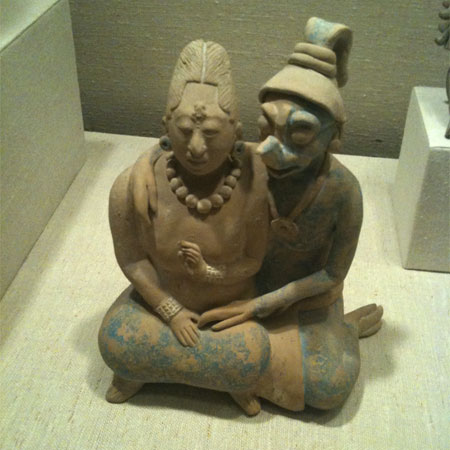
(Couple with Anthropomorphic Deity; Mexico; Maya; 7th–9th century; ceramic. Lent by a private collection, 2008. L.2008.41.8)

Books
Films
(Illustration from Le Théâtre et Comoedia illustrée of the original theatrical production of Raymond Roussel’s Locus Solus in 1923, from Livrenblog by way of A Journey Round My Skull.)
“But this knowledge of history did not deflect my sadness. She saw my whole despair and, one afternoon as I returned home from the club, she said: “Perhaps even now it is not too late. Change style. Learn to snap. Leave government service, plunge into jungles of commerce.”
(Donald Barthelme, “Snap Snap,” Guilty Pleasures, p. 33.)
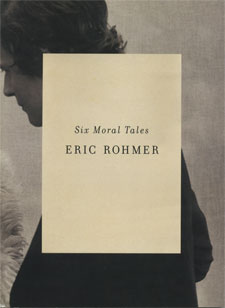 Éric Rohmer
Éric Rohmer
Six Moral Tales
(trans. Sabine d’Estrée)
(Viking Press, 2009)
Amazon had the Criterion Six Moral Tales box set for cheap after Éric Rohmer died; I took them up on it, and I’ve been working my way through them. The box set includes six DVDs; in addition to a booklet of critical essays, Rohmer’s book of short stories made from the films is also included. It’s a substantial book (262 pages); off the top of my head, I can’t think of other editions of films that have privileged a text counterpart so much. Criterion’s edition of Last Year at Marienbad, for example, doesn’t include the out-of-print Grove edition of the book, illustrated with the film stills. Nor are there that many films that are so directly connected to literary fiction authored by the director: Antonioni’s That Bowling Alley on the Tiber comes to mind, but there’s a difference between the short stories in that and the films. There’s Marguerite Duras, of course, and Georges Perec, but the films they directed aren’t especially well-known; the exception might be Duras’s India Song.
I’ve been reading the stories after watching all the films, so it’s taken me a while to make my way through this. Reviews of the Six Moral Tales often say that they’re based on a novel; the back cover of this edition says that “years before Eric Rohmer turned to filmmaking, he wrote his famed Six Moral Tales in book form,” which echoes Rohmer’s statement in his preface that the stories “are not adapted from my films.” These assertions are misleading; Rohmer’s is disingenuous. This isn’t a novel; rather, it’s six short stories where the same basic plot (boy has girl; boy meets other girl; boy considers straying) is reenacted, almost in the manner of Queneau’s Exercises in Style. The French copyright date on this is 1974, two years after the last of the films; in addition, it seems clear that these stories were (at the very least) reworked after the making of the films, something more noticeable because the stories and the films are extremely similar.
At the start of the film of La Collectionneause, for example, is a scene where a painter, played by Daniel Pommereulle, talks to an art critic, played by Alain Jouffroy. Jouffroy disappears from the film after this scene; the painter, who is the third-most important character in the film, is identified by others as “Daniel”. The viewer may not know that Jouffroy is best known as an art critic, and that Pommereulle is generally known as an artist. This situation is further confused by the same scene’s treatment in the text:
Daniel – Daniel Pommereulle, to give his full name – is one of those contemporary painters who durin the sixties tossed their paintbrushes into the garbage and turned their creative energies to the manufacture of “objects.” The art critic Alain Jouffroy called them “Objectors,” and in the art magazine Quadrum published an article under this title devoted to their work. The year is 1966, and Jouffroy is paying a visit to Daniel’s studio. (p. 129.)
The article mentioned actually exists – “Les Objecteurs: La ‘Distance infinie’ de Duchamp,” Quadrum, no. 19, 1965, pp. 6–9. La Collectionneuse was released in 1967; possibly the scene was shot in 1966. One wonders, however, whether the conversation between Jouffroy and Pommereulle that follows is theirs or Rohmer’s. The acting credits in the film begin “avec la collaboration pour l’interprétation et les dialogues de”; what’s said in the film is very close to the text, but inexact. Although it’s isolated, almost certainly their scene in the film isn’t documentary: there’s too much relevance to what happens later. The first paragraph of the story, titled “Haydee,” physically describes the main character of the story; the name of this character, the “collectionneuse” of the title, is that of the actress Haydee Politoff, and the description physically matches the actress.
Or again: in “Claire’s Knee,” Jerome explains to Madame W. and Laura that “he and Aurora first met, six years before, when he was the cultural attaché in Bucharest” (p. 173). Why Bucharest? Presumably because Aurora Cornu, who plays a writer in the film, is a Romanian writer. There’s a further overlay here: Aurora (the character) is a writer and claims that she wants to write use Jerome as a character in her book. It’s not by chance that Aurora and Jerome look at a painting of Don Quixote: as Vargas Llosa noted, in the first book, Quixote makes the mistake of trying to read the world through the lens of a book, while in the second, the world, having read the book about Quixote, keeps expecting him to act like a character in it. Rohmer’s introduction again: “My heroes, somewhat like Don Quixote, think of themselves as characters in a novel, but perhaps there isn’t any novel.”
All of these stories tell the story of a male lead who passes through a point of crisis; all of the narrators attempt to justify their generally reprehensible behavior to themselves with flimsy reasoning, the morality of which is belied by the damage they end up doing to others. The most interesting use of this is in the fifth story, “Claire’s Knee,” where Jerome justifies his desire to be unfaithful by explaining to his novelist friend Aurora (who may be a past lover) that he’s acting in the interest of providing her with a story. There’s a distinct echo here of Choderlos de Laclos: and while Aurora, who is at least partially a stand-in for the director, finds his storytelling useful, she’s aware that his stated reasons aren’t his real ones. As in Les Liaisons dangereuses, the relationship between these two characters is more interesting than what they’re plotting; Jerome, however, isn’t aware enough to notice Aurora’s interest in him, or to notice that she, who he has taken as single, has her own distant fiance. The libertine echoes return in “Love in the Afternoon”: early on, the narrator describes his escape by reading in the subway:
On the train, I much prefer reading books to newspapers, not only because newspapers are cumbersome but also because I can’t immerse myself in the papers. Books lead me further afield, and at present I’m very much taken with books on exploration. Today’s book is entitled Voyage autour du Monde by Bougainville. (pp. 217–8.)
Bougainville’s description of Tahiti as paradise, source of the idea of the “noble savage” almost certainly isn’t what the narrator is reading: more likely he’s reading Diderot’s response, Supplément au voyage de Bougainville which sees in the sexual freedom of the Tahitians a model for the libertine reinvention of Western society. (In the film, it’s clear that the narrator’s edition includes Diderot’s supplement.) This also presages Chloe’s later argument against marriage, which the narrator finds tempting, but rejects, that polygamy isn’t degrading to women if women also practice it. For the narrator, it’s an escape from his present bourgeois reality; but it’s not one that he will follow up on.
These stories can’t be separated from the films, and were presumably meant to be read in conjunction with them, although this would have been very difficult for most readers in the 1970s when the films wouldn’t have been immediately accessible as they are now. The films were made from 1962 to 1972; they blossom from black and white shorts about students to full-color feature films about first affianced and finally married couples. While the characters don’t recur – save for a dream sequence in Love in the Afternoon, not reflected in the story – there’s an implicit story of growth, of a director growing more confident with himself. This growing maturity isn’t reflected as much in the stories: while the stories are more complex, Rohmer isn’t interested as much in the different ways that narrative voice can function in fiction. Most of these stories are told in the first person, echoed strongly by the voiceovers of the first films. “La Collectionneuse” starts in the third person from several perspectives (the film’s “prologues”) before it switches to the first. Only “Claire’s Knee” differs, being told in a the third person; this is generally from the perspective of Jerome, but at the end it suddenly switches over to Aurora with a scene that could only be seen by her: “The boy’s left arm is around Claire’s shoulder, and his right hand is caressing her knee.” (p. 213) This isn’t quite reflected in the film: there, the actors sit on a bench with their backs to the camera. The boy may be caressing her knee with his left hand (which would have mattered more to Jerome than to Aurora), but the viewer can’t see this; had the viewer not read the text, they almost certainly would not have presumed this. These are stories that are better told as films, where the camera’s perspective can be unhinged from the task of straightforward narration.